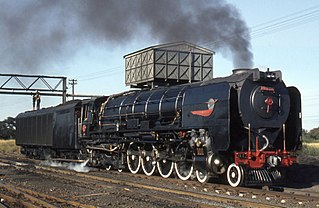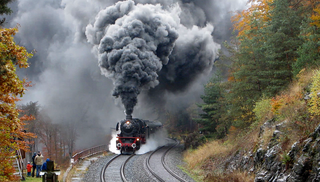Under the Whyte notation for the classification of steam locomotive wheel arrangements, a 2-10-10-2 is a locomotive with two leading wheels, two sets of ten driving wheels, and a pair of trailing wheels.

A surface condenser is a commonly used term for a water-cooled shell and tube heat exchanger installed on the exhaust steam from a steam turbine in thermal power stations. These condensers are heat exchangers which convert steam from its gaseous to its liquid state at a pressure below atmospheric pressure. Where cooling water is in short supply, an air-cooled condenser is often used. An air-cooled condenser is however, significantly more expensive and cannot achieve as low a steam turbine exhaust pressure as a water-cooled surface condenser.

A condensing steam locomotive is a type of locomotive designed to recover exhaust steam, either in order to improve range between taking on boiler water, or to reduce emission of steam inside enclosed spaces. The apparatus takes the exhaust steam that would normally be used to produce a draft for the firebox, and routes it through a heat exchanger, into the boiler water tanks. Installations vary depending on the purpose, design and the type of locomotive to which it is fitted. It differs from the usual closed cycle condensing steam engine, in that the function of the condenser is primarily either to recover water, or to avoid excessive emissions to the atmosphere, rather than maintaining a vacuum to improve both efficiency and power.

The steam-electric power station is a power station in which the electric generator is steam driven. Water is heated, turns into steam and spins a steam turbine which drives an electrical generator. After it passes through the turbine, the steam is condensed in a condenser. The greatest variation in the design of steam-electric power plants is due to the different fuel sources.

The Franco–Crosti boiler is a type of boiler used for steam locomotives. It was designed in the 1930s by Attilio Franco and Dr Piero Crosti. The main difference between it and conventional feedwater heaters widely used on the continent is that the Franco-Crosti boiler uses both exhaust steam and exhaust gases from the firebox. Conventional feedwater heaters only use exhaust steam.
A deaerating feed tank (DFT), often found in steam plants that propel ships, is located after the main condensate pump and before the main feed booster pump. It has these three purposes:
- Remove dissolved oxygen (“air”) from the condensate
- Pre-heat the feedwater
- Provide a storage/surge volume
The locomotives WURZEN and OSCHATZ were early German steam engines operated by the Leipzig–Dresden Railway Company (LDE) for mixed duties. They were tender locomotives.
The ELBE to HAYN series of early, German, steam locomotives were equipped with tenders and operated by the Leipzig–Dresden Railway Company.
The RICHARD HARTMANN to ZWICKAU series of early German locomotives were express train tender locomotives operated by the Leipzig–Dresden Railway Company.
Boilers for generating steam or hot water have been designed in countless shapes, sizes and configurations. An extensive terminology has evolved to describe their common features. This glossary provides definitions for these terms.
Kirchweger is a German surname. Notable people with the surname include:

The South African Railways Class 25 4-8-4 of 1953 was a condensing steam locomotive.

A high-pressure steam locomotive is a steam locomotive with a boiler that operates at pressures well above what would be considered normal. In the later years of steam, boiler pressures were typically 200 to 250 psi. High-pressure locomotives can be considered to start at 350 psi (2.41 MPa), when special construction techniques become necessary, but some had boilers that operated at over 1,500 psi (10.34 MPa).

An evaporator, distiller or distilling apparatus is a piece of ship's equipment used to produce fresh drinking water from sea water by distillation. As fresh water is bulky, may spoil in storage, and is an essential supply for any long voyage, the ability to produce more in mid-ocean is important for any ship.

The South African type CL tender was a condensing steam locomotive tender.

The South African type CZ tender was a condensing steam locomotive tender.













